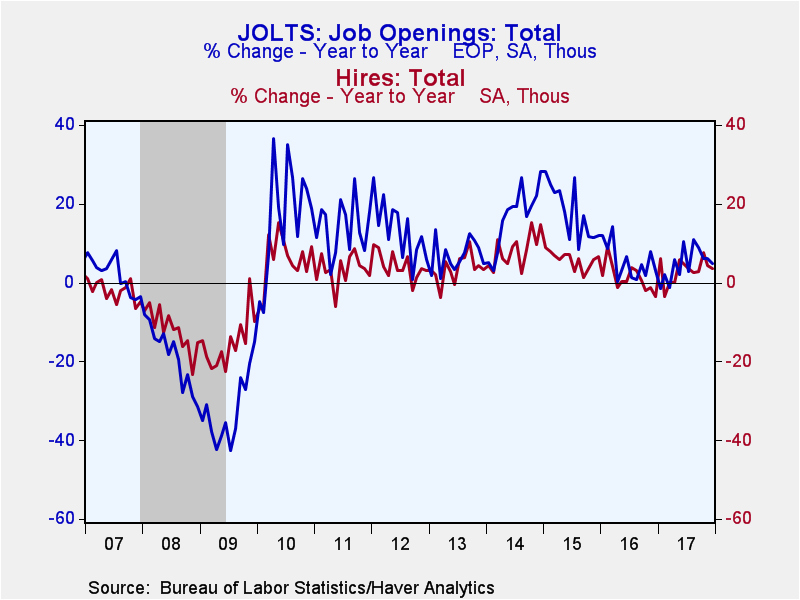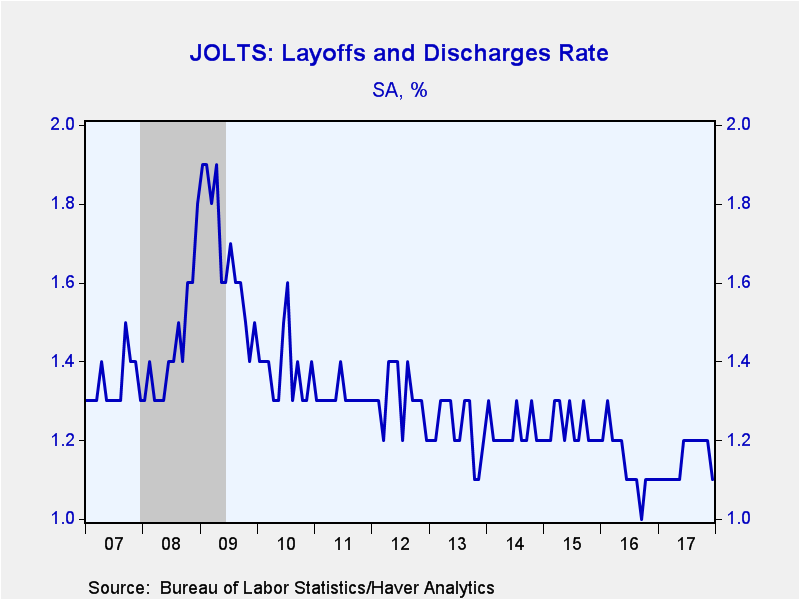 Global| Feb 06 2018
Global| Feb 06 2018U.S. JOLTS: Job Openings and Layoffs Edge Down; Hiring Unchanged
Summary
The Bureau of Labor Statistics reported that the total job openings rate in December notched down to 3.8% from 3.9% in November. At the end of 2016 the job openings rate was 3.7%. The hiring rate was unchanged at 3.7%, slightly higher [...]
The Bureau of Labor Statistics reported that the total job openings rate in December notched down to 3.8% from 3.9% in November. At the end of 2016 the job openings rate was 3.7%. The hiring rate was unchanged at 3.7%, slightly higher than the 3.6% reading from a year ago. The layoff rate declined to 1.1% in December from 1.2% in November, but was unchanged from a year ago. These figures are from the Job Openings & Labor Turnover Survey (JOLTS), which dates back to December 2000.
The private sector job openings rate edged down to 4.1% in December; a year ago it was 4.0%. Monthly declines in construction, manufacturing, trade, transportation & utilities and professional services were offset by gains in education & health and leisure and hospitality. Job Openings in the government sector increased to 2.3% in December from 2.2% in November.
The total number of job openings fell 2.8% in December, driven by a 3.2% drop in private sector openings. Still, total economy job openings are up 4.9% from a year ago, while private sector openings have risen 4.4% year-on-year. Openings in leisure and hospitality led the gain, rising 22% from a year ago, followed by construction (13% y/y), trade and transportation (7% y/y) and manufacturing (6% y/y). Openings in the professional services and educational and health were down for the year. Meanwhile, openings in government were up 10% from a year ago.
The private sector hiring rate was unchanged at 4.1% in December with little movement in individual industries. Private sector hiring edged up 0.2% in December with a 2.9% gain for the year. The factory sector led the gain, up 20% from a year ago, while hiring in construction was down 16% year-on-year. Government hiring fell 3.8% in December but was up 12.5% year-on-year. As a result, the overall number of hires edged down 0.1% in December and was up 3.5% from a year ago.
The overall job separations rate increased to 3.6% in December from 3.5% in November. The separation rate has ranged between 3.4% and 3.6% during the last two years. The layoff & discharge rate was unchanged at 1.1% in December. The layoff rate has been hovering between 1.1% and 1.2% for the last 15 months. Total layoffs fell 4.6% in December, but were up 1.3% from a year ago. Private sector layoffs dropped 6.1% for the month, but were down only 0.3% from a year ago.
The JOLTS survey dates to December 2000 and the figures are available in Haver's USECON database.
| JOLTS (Job Openings & Labor Turnover Survey, SA) | Dec | Nov | Oct | Dec '16 | Dec '15 | Dec '14 | |
|---|---|---|---|---|---|---|---|
| Job Openings, Total | |||||||
| Rate (%) | 3.8 | 3.9 | 3.9 | 3.7 | 3.6 | 3.3 | |
| Total (000s) | 5,811 | 5,978 | 5,925 | 5,539 | 5,374 | 4,795 | |
| Hires, Total | |||||||
| Rate (%) | 3.7 | 3.7 | 3.8 | 3.6 | 3.8 | 3.7 | |
| Total (000s) | 5,488 | 5,493 | 5,592 | 5,303 | 5,504 | 5,165 | |
| Layoffs & Discharges, Total | |||||||
| Rate (%) | 1.1 | 1.2 | 1.2 | 1.1 | 1.2 | 1.2 | |
| Total (000s) | 1,645 | 1,725 | 1,693 | 1,624 | 1,732 | 1,720 | |
Gerald D. Cohen
AuthorMore in Author Profile »Gerald Cohen provides strategic vision and leadership of the translational economic research and policy initiatives at the Kenan Institute of Private Enterprise.
He has worked in both the public and private sectors focusing on the intersection between financial markets and economic fundamentals. He was a Senior Economist at Haver Analytics from January 2019 to February 2021. During the Obama Administration Gerald was Deputy Assistant Secretary for Macroeconomic Analysis at the U.S. Department of Treasury where he helped formulate and evaluate the impact of policy proposals on the U.S. economy. Prior to Treasury, he co-managed a global macro fund at Ziff Brothers Investments.
Gerald holds a bachelor’s of science from the Massachusetts Institute of Technology and a Ph.D. in Economics from Harvard University and is a contributing author to 30-Second Money as well as a co-author of Political Cycles and the Macroeconomy.









